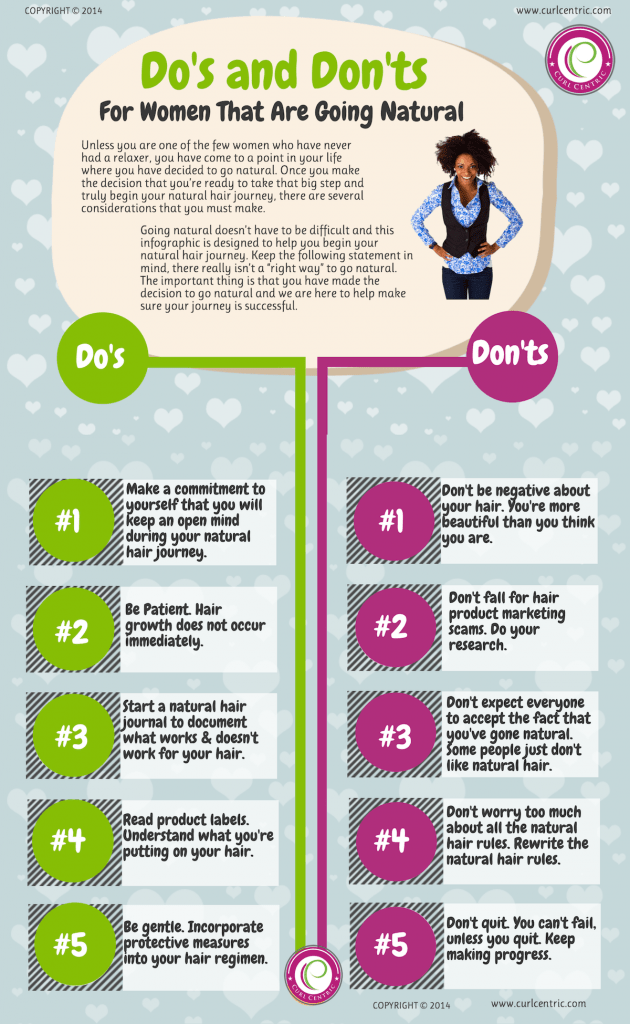
Going natural from relaxed hair seems to be a hot topic of late, simply because many women who decide to go natural would rather not big chop their hair.
If you're new to the natural hair movement, big chopping is the act of cutting off your relaxed hair.
However, before we dive into detailed specifics and tactics for taking care of your hair, let's take a step back and start from the beginning - defining the term "natural hair".
Table of Contents
What is Natural Hair?
The first step for going natural and progressing towards a rewarding natural hair experience is understanding what the term natural hair actually means.
There are multiple definitions of the term online, but we tend to use the most common definition:
Natural hair is defined as african american hair or similar hair types that is relaxer-free. However, some people may say perm-free or chemical-free.
While people who use the terms perm-free and chemical-free are likely referring to natural hair and the process of going natural, those terms are technically inaccurate interpretations of what natural hair really means.
Even though chemicals are usually thought of as harmful, chemicals are, in most cases, pretty harmless.
For example, water is a chemical that people come across each and every day, and water is one of the most necessary elements for life to survive. So, not all chemicals are destructive.
Black natural hair, which is sometimes thought of as “nappy hair”, is often described as a hair type that needs "fixing" with relaxers.
Situations also often occur in which African American women get treated unfairly by their employers who say that black natural hairstyles are not professional.
Natural hair has also caused some women to be overlooked or not really considered for promotional opportunities at work or for new employment opportunities and has even caused some couples to have relationship problems.
If you want assistance in transitioning or want to obtain resources to help you care for your natural hair, this article is for you.

Understanding Black Natural Hair
There is one clear-cut reason that the various hair types (like 3a, 4b, LOIS, etc.) are not the focal point of this article. There are many common things that most women have to do to take care of their hair.
No matter what type of hair you have, there are common tips, techniques, and strategies that promote healthy hair. We will several discuss several of those strategies within this article.
For example, try to cut back on (or eliminate) heat styling, keep your hair clean, make sure that you stay hydrated, and try to keep your stress level at a minimum.
Also, it’s not uncommon to have more than one type of hair on your head (multiple textures), so our focus isn't aimed at the various hair types because there are other things that are common ground for many more people. This statement is especially true for new naturals.

Going Natural From Relaxed to Natural Hair
When going natural from relaxed hair, there really isn't a correct way to do it. Please don't listen to other naturals that tell you that you're going natural the wrong way.
Regardless of what others tell you, there really isn't a right or wrong way to do it. To state it simply, once you decide that you're not getting another relaxer, you are officially transitioning to healthy natural hair.
Try to identify the boundary between the meeting point of your relaxed and natural hair. This meeting point is called the line of demarcation for your "transitioning hair". It is usually easy to find the line of demarcation because the natural hair texture will change at this point.
During your natural hair journey, it is really important to listen to your hair because it will ultimately let you know what it needs. New naturals often struggle to understand what this means.
Listening to your hair simply means recognizing problems and either mitigating and/or correcting whatever was causing the problem in the first place.
Be sure to focus on fixing the root cause and not covering it up - more about this later.
To be clear, I will give you an example. If you begin to notice that your hair products no longer work like they once did, then it might be time for a clarifying session.
You can accomplish this by using a clarifying shampoo to remove product build-up, which should give your natural hair a squeaky clean feeling.
New naturals - especially ones who have decided to transition, can benefit tremendously by starting a natural hair journal.
Next, a crucial step to going natural from relaxed hair is finding your first set of products.
This is where many naturals spend hundreds of dollars, sometimes thousands of dollars, trying new products. This process of continuing to buy product after product is addictive for many women.
These women are often referred to as product junkies.
The term "product junkie" can be used in a derogatory manner, but like other terms in the black community, it can also be used as a term of endearment as well.
So, don't immediately get pissed off if someone refers to you as a product junkie. Many times product junkies are simply chasing a better product.
It's an endless attempt to find the perfect product (aka holy grail product) that matches their needs perfectly; they usually invest quite a bit of time and money into trying new products until they find the right one(s).
So, do not get discouraged when you don’t find the right product right away. You will learn to better understand your hair as you try different products and will ultimately find the products that are right for you.
Advice: Start your natural hair journal to begin learning and documenting what your hair likes and dislikes.

The Hair Shedding Truth
It's not abnormal to lose one hundred or more hairs each day due to shedding. There are four phases involved in the hair growth cycle.
The growth phase is called anagen, and the transitional phase is called catagen. During any particular time, somewhere around 90% of your hair follicles are in these stages.
The third phase is known as resting or telogen. Finally, the fourth phase, which is the shedding phase, is called exogen.
Roughly 10% of your hairs are in the telogen or exogen phases at any given time, and these hairs fall out in around three months.
Everyone’s head of hair is different, but most hairs grow about a half-inch (½ inch) every month.
The phase of active growth is fairly short, and because of this, some people experience trouble getting their hair to grow past a set length.
Many people confuse their personal growth issues with the concept of terminal length. The terminal length refers to a limitation that your hair has to grow past a particular length.
Advice: As long as the shedding does not seem to have gone completely overboard, worrying about shedding is almost always unnecessary.
If it does seem overboard, look into these areas: medications currently being taken, stress, any potential illnesses, nutrition, and dieting, tight hairdos, changes in hormones, or Alopecia Areata.
Many of the areas may require a licensed medical professional (like a doctor) to properly diagnose the main cause of the hair shedding that you are experiencing.

Prevention of Split-ends and Hair Breakage
Your hair is a dead, non-living material. This is why you can have it cut with scissors, flat iron it, or put harsh chemicals on it and not feel anything.
However, the main problem is because your hair is dead, it can’t fix itself once it has been damaged.
This explains why the process of going natural from relaxed hair is necessary. Your relaxed hair is damaged and can't be repaired.
Damaged hair can always be removed, either by trimming it away or by growing it out. For example, there is no permanent cure for split ends, although some people will disagree with that.
There are conditioners that can actually temporarily repair split ends, but the repair or fix is not permanent. These same split-ends will eventually come back after a period of time.
One common cause of excessive breakage is tight hairstyles, such as really tight box braids and tight ponytails.
If you experience constant breaking, you should attempt to determine the root cause of the breakage. Harsh chemical use, tight styles, harsh treatment, and heat are the most traditional causes of breakage.
Advice: Popular heating appliances and hot tools, such as pressing combs, curling irons, and flat irons, can cause damage to the hair strand (ruining your natural curls) because of the high temperatures.
If you choose to utilize heat, you should take precautions to mitigate heat damage - like using a heat protectant. It's important to know that it is impossible to completely protect your hair from heat damage.
Use this test: If a heating appliance is so hot that it can burn your skin, there is a very good chance that the appliance is hot enough to cause heat damage.
This is a very simple test, and it's definitely not a guarantee against heat damage, but it's a good test to do nonetheless - because it's directionally accurate.
This simply means that higher heat settings have a greater chance of causing heat damage on a probability basis.
Finally, manipulating your hair too often can increase the chance of breakage.
So, be certain to steer clear of chemical processes (like relaxers) that have the potential to change the natural texture of your hair and stay away from excessively tight hairstyles.
Supplements, Nutrition, Vitamins, and Health
In general, if food is nutritious and good for your body, it will help you have hair that is healthier. Unhealthy eating could negatively impact the health of your hair as well.
Supplements and vitamins can be helpful in reaching the full potential of your hair if you have certain medical conditions or do not eat a nutritious, balanced diet.
Advice: Don’t spend your money on supplements and vitamins (like biotin) unless you don’t eat a healthy diet or have certain medical conditions.
Exercise
There is no scientific proof that exercise has any positive effects on the health of your hair.
Advice: Regular exercise can have positive effects on your hair, but only indirectly by reducing stress and promoting good overall health.
Hairstyling Advice
Protective styles are crucial to making significant growth progress with your natural hair.
There are plenty of benefits to protective styles: length retention, and minimal manipulation, they should give you the opportunity to moisturize daily, and they should help to keep the ends of your hair "protected".
Advice: Find a few protective styles that you like and add them to your natural hair regimen. The key is to keep the ends of your hair protected to encourage length retention.
Protective styles help you grow longer hair (actually retain length) by mitigating breakage, so you can keep the hair that you've grown.
Some good protective hairstyles to try are buns, updos, braids, and french rolls. Pick at least one protective style that you like and add more over time. Outside of simply adding more protective styles to your regimen, try to add more protection to your regimen overall.
Don't fall into the trap of thinking that protective styling is only about protective styles (more about that here).
Troubleshooting
When going natural from relaxed hair, there may be several things that you have to deal with: multiple textures, dandruff, and dryness are only a few of the problems that you might encounter.
When having difficulties with your hair, the first thing you should do is go to your journal because it is the best place to look when trying to correct problems during your journey. Try to understand the root cause of the issue.
Some questions to ask could be: Has your routine changed at all? Did you recently introduce a new product into your regimen?
Have you changed how you're using your products? Have you started taking a new medication? Have you started a new job that is stressing you out?
There are so many questions that you could potentially ask that would shed light on the potential problem. The key is to focus on understanding the problem and then solving the problem.
Don't immediately start treating the symptoms without understanding what's causing the problem.
Chlorine, heat, exposure to the sun or wind, sulfate-filled shampoos, and hard water are just some of the factors that can cause extremely dry hair externally.
Internally, medicines and deficiencies in nutrients can also cause various problems.
Advice: Always work to find the root cause of the problem that you're experiencing and attempt to cure that problem.
Lastly, as you work your way through the process of going natural (whether you decide to transition or big chop), we are right here to help you along the way.
Can Going Natural Damage Your Hair?
Going natural (i.e., transitioning to natural hair and using natural hair care products) does not inherently damage hair. Many people find that going natural can lead to healthier and more manageable hair. However, the transition process can be challenging, especially for those previously using chemical relaxers or other treatments.
What Does Going Natural Mean?
Going natural typically refers to transitioning from chemically altered hair (relaxed/permed hair) to natural hair that has not been chemically treated. It involves growing out the chemically treated hair, gradually cutting off the relaxed ends, or doing the "big chop" and cutting off all of the chemically treated hair at once to start fresh with natural hair.
How Often Should You Wash Your Hair When Going Natural?
While some people prefer to wash their hair every day, others may only wash their hair once a week or less. It's recommended to wash natural hair every 7-10 days to maintain a clean scalp and healthy hair. Remember that over-washing can strip the hair of natural oils, while under-washing can lead to product build-up and scalp irritation.
Does Going Natural Help Hair Grow?
Going natural hair may help promote hair growth, as natural hair care practices focus on keeping the hair healthy and nourished. By avoiding chemical relaxers and other harsh treatments, natural hair can be less prone to breakage and damage, which can help the hair grow longer and stronger over time.
- Protective Hairstyles That Can Get Wet
- Going Natural Without the Big Chop
- Should I Wet My Natural Hair Every Day?
- How Often Should You Moisturize Your Hair
Do's and Don'ts [Infographic]
If you have any questions about going natural from relaxed hair, please ask them in the comment section.





